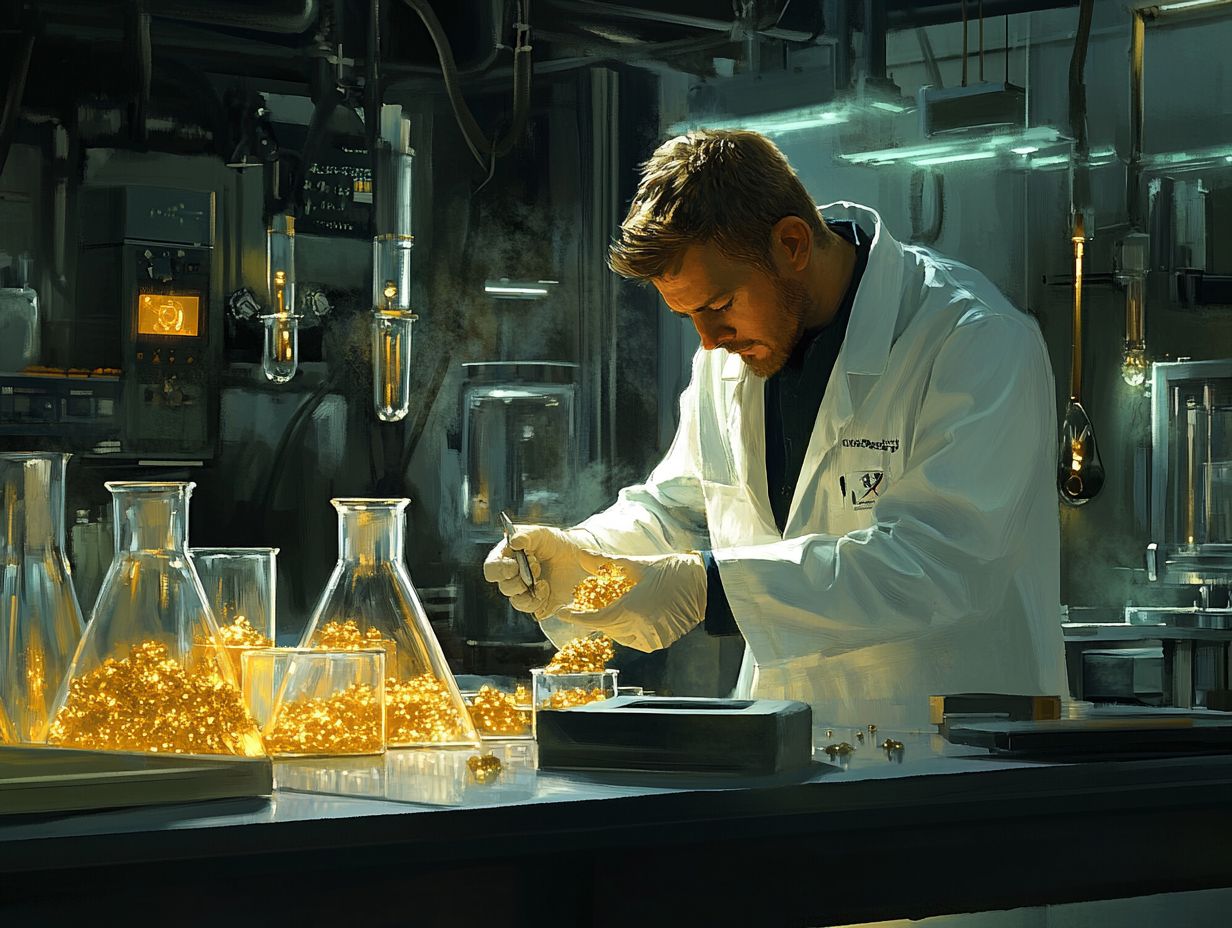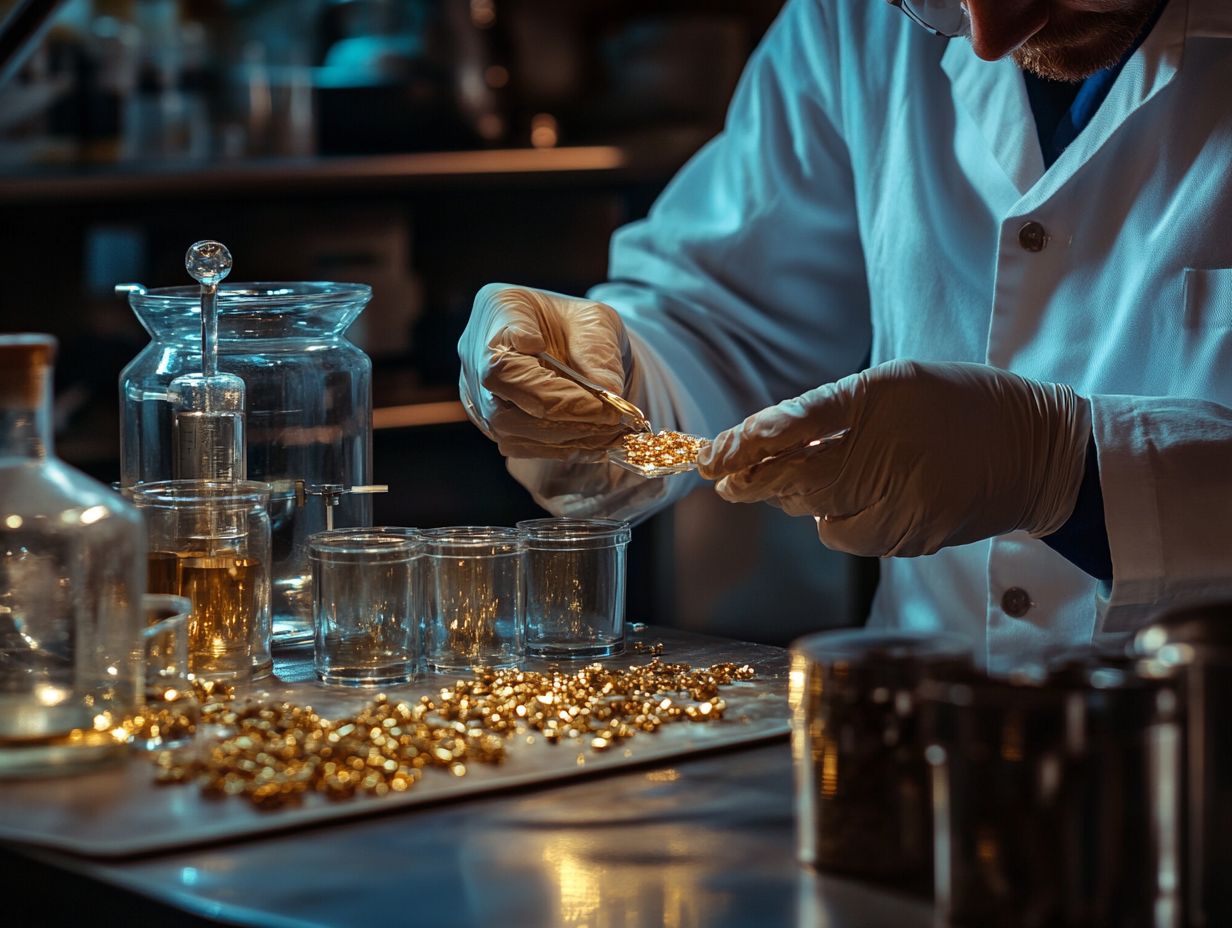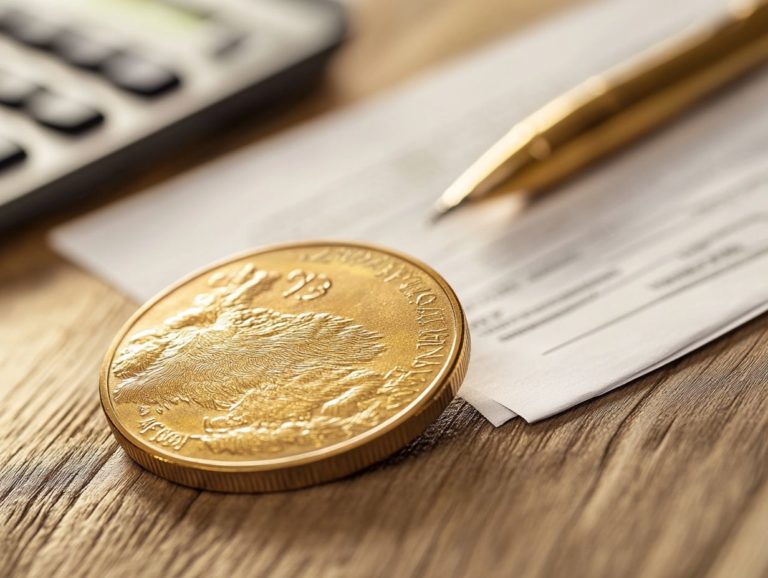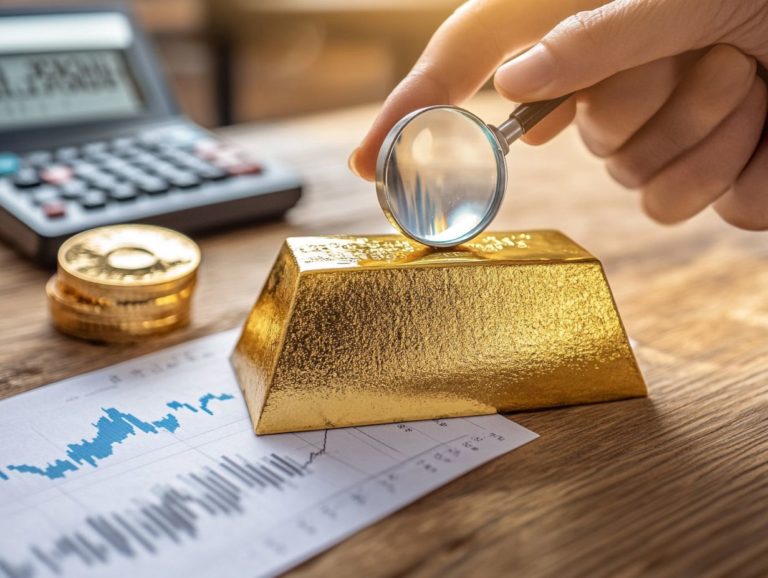What is Precious Metal Refining?
Precious metal refining is an essential process that converts raw metals into high-purity forms, making them ideal for various applications. This article will take you on a fascinating journey through the refining process, exploring different types of precious metals like gold, silver, and platinum, while also highlighting their industrial and commercial uses.
You ll discover the economic and environmental benefits of refining and the challenges that come with it. This practice enhances value and significantly influences the broader market and environment.
Contents
- Key Takeaways:
- The Refining Process
- Types of Precious Metals
- Uses of Refined Precious Metals
- Benefits of Precious Metal Refining
- Challenges and Considerations
- Frequently Asked Questions
- What Exactly is Precious Metal Refining?
- Why is Precious Metal Refining Necessary?
- What Steps are Involved in Precious Metal Refining?
- What Common Methods are Used in Precious Metal Refining?
- What Materials Can Be Refined Through Precious Metal Refining?
- Is Precious Metal Refining Harmful to the Environment?
Key Takeaways:

- Purifying and extracting valuable metals from raw materials for various industrial and commercial uses.
- Involves several steps, including chemical reactions and melting, to produce high-purity metal products.
- Contributes to economic growth and sustainability through applications in electronics, jewelry, and medical equipment.
Definition and Purpose
The definition and purpose of precious metal refining involve intricate processes for extracting and purifying valuable metals such as gold, silver, platinum, and palladium. These metals are vital to many industries, including electronics, jewelry manufacturing, and dental applications.
Engaging in this refining process supports eco-efficient recycling initiatives and reduces the need for mining, promoting sustainable practices in the precious metals market. By utilizing techniques like electrolysis and chemical leaching (a process that uses chemicals to extract metals), you can turn old electronics and unwanted jewelry into high-quality metals.
The services offered in this sector not only cater to manufacturers but also strengthen the circular economy by ensuring that precious metals are reused rather than discarded. This practice is crucial for minimizing environmental impact; it conserves natural resources and reduces the carbon emissions associated with mining.
The Refining Process
The refining process for precious metals is a meticulous journey aimed at extracting and purifying valuable materials from precious scrap and non-ferrous metals. This ensures that the final product meets the highest industry standards for purity and quality.
This procedure uses advanced techniques such as fire assay, atomic absorption, and base metal removal to expertly separate precious metals like gold, silver, platinum, and palladium from impurities.
Step-by-Step Breakdown
A step-by-step breakdown of the refining process highlights the attention to detail necessary for maximizing precious metal extraction and providing benefits such as swift payouts to customers. Each phase, from initial scrap processing to final purification, plays a critical role in optimizing recovery rates and ensuring reliability among refiners.
- Your journey begins with careful sorting of materials, a vital step to maximize recovery efficiency.
- Advanced sorting technologies like X-ray fluorescence (XRF) and laser-induced breakdown spectroscopy (LIBS) are used to accurately identify pure metals and alloys.
- After sorting, materials undergo shredding and granulation to increase surface area for quicker and more effective chemical reactions during refining.
Once prepared, various chemical processes such as cyanidation and aqua regia (a mixture of hydrochloric and nitric acids used to dissolve gold) are implemented to dissolve the metals from impurities. Throughout the refining process, constant monitoring ensures optimal conditions, ultimately enhancing precious metal yield, elevating customer satisfaction, and driving significant economic returns.
Types of Precious Metals

You ll often find precious metals like gold, silver, platinum, and palladium in refining. Each metal has unique properties and plays crucial roles across various industries, from jewelry manufacturing to electronics.
Understanding the distinct characteristics of these metals, along with the subtleties within the platinum group metals, is vital for mastering precious metal recycling and refining. Additionally, knowing what a precious metals dealer is can further enhance your knowledge in this field.
Gold, Silver, Platinum, and More
Gold refining is an essential process that guarantees high purity and quality, allowing for its diverse applications in electronics and jewelry. It often utilizes the Miller and Wohlwill processes, which achieve impressively high purity levels crucial for both investment and jewelry markets.
Silver refining, on the other hand, typically employs electrolysis or chemical methods to eliminate impurities. This makes it perfect for use in solar panels and batteries.
In terms of platinum and palladium, techniques such as acid leaching a chemical process to extract metals and carbon-in-pulp processes are commonly applied. These methods underscore their significance in catalytic converters and other advanced applications.
Understanding these methods helps you appreciate the meticulous work behind metal recovery and recognize their vital role in contemporary technology and sustainability.
Uses of Refined Precious Metals
Refined precious metals hold significant value across both industrial and commercial sectors. They play crucial roles in jewelry manufacturing, electronics, and numerous other industries that demand top-tier materials.
The remarkable versatility of these metals, characterized by outstanding conductivity and corrosion resistance, renders them essential for both technological innovations and aesthetic applications.
Industrial and Commercial Applications
Applications of refined precious metals are critical in various fields, including electronics, dentistry, and jewelry. Their unique properties enhance product quality and performance.
In electronics, gold and silver are preferred for their exceptional conductivity, significantly boosting the efficiency of devices like smartphones and computers.
In dental practices, refined metals such as palladium and gold are chosen for their safety for the body and durability in crowns and bridges, ensuring long-lasting oral health solutions.
In the jewelry industry, the luster and tarnish resistance of refined silver and platinum elevate the aesthetic appeal of pieces, making them increasingly desirable to consumers. Each application highlights how the intrinsic properties of refined precious metals not only meet practical needs but also drive innovation and sustainability.
Benefits of Precious Metal Refining

The advantages of precious metal refining extend beyond economic gains; they also include substantial environmental benefits that foster sustainable practices within the refining sector.
By facilitating the recycling of precious metals, you can reduce the demand for mining, conserve valuable natural resources, and support a circular economy that emphasizes the recovery and reuse of materials.
Act now to discover the immense potential of refined precious metals!
Economic and Environmental Advantages
The economic advantages of refining precious metals come with environmental benefits. These benefits support environmentally friendly recycling initiatives and enhance the precious metals market as a whole.
By employing effective refining processes, you can maximize returns while minimizing environmental impact. This paves the way for a sustainable future in the precious metals sector.
Beyond boosting profitability, these environmentally friendly practices lead to significant reductions in waste and energy consumption. A study by the Environmental Protection Agency shows that modern refining techniques can reduce energy usage by up to 50%. This can dramatically lower your operational costs.
Companies like Umicore exemplify how sustainable methods bolster financial performance and diminish harmful emissions. These advancements contribute to a circular economy, ensuring that precious metals are reused and recycled. This, in turn, conserves natural resources and reduces the need for mining, which carries its own ecological repercussions.
Challenges and Considerations
The refining industry faces challenges and considerations, including potential risks and limitations that may impact the trustworthiness of refiners and the overall integrity of the refining process.
Understanding these challenges is essential for you as a stakeholder. This understanding enables you to make informed decisions regarding your precious metal recycling and refining needs.
Key Risks and Limitations in Refining
Potential risks and limitations in the refining process can significantly shape the efficiency and outcomes of your precious metal recovery. These factors ultimately influence your clients’ satisfaction and your trustworthiness as a refiner.
You must navigate factors such as market volatility, processing challenges, and regulatory compliance with care to ensure your refining operations are successful.
If you encounter unexpected fluctuations in precious metal prices without adaptive pricing methods, you could face financial losses. Improper handling of hazardous materials can pose safety risks and lead to serious legal repercussions.
To tackle these challenges, implement comprehensive training programs for your staff and invest in advanced technology that enhances processing accuracy. Establishing transparent communication channels with your clients fosters trust and ensures they feel confident that their precious metals are treated with the utmost care and professionalism.
By adopting a rigorous compliance framework, you can transform potential liabilities into advantages, ensuring adherence to regulatory standards while nurturing long-term relationships with your clients.
Frequently Asked Questions

What Exactly is Precious Metal Refining?
Precious metal refining is the process of extracting valuable metals such as gold, silver, and platinum from raw materials like ore, jewelry, and electronic scrap.
Why is Precious Metal Refining Necessary?
Precious metal refining is necessary because it allows for the extraction and purification of valuable metals from their raw forms. This process is essential for obtaining high-quality and pure precious metals for various industries and applications.
What Steps are Involved in Precious Metal Refining?
The steps involved in precious metal refining include melting, chemical treatment, electroplating, and filtration. The specific processes used may vary based on the type and purity of the metal being refined.
What Common Methods are Used in Precious Metal Refining?
- Cupellation
- Cyanide leaching
- Electrolytic refining
Each method has its advantages and is used for specific types of precious metals.
What Materials Can Be Refined Through Precious Metal Refining?
Precious metal refining can be applied to various materials, including gold, silver, platinum, palladium, and other rare and valuable metals found in ores, jewelry, and electronic devices.
Is Precious Metal Refining Harmful to the Environment?
Is precious metal refining safe for our planet? With proper regulations and responsible practices, it can be done in a way that protects the environment.
Many refineries now use clean methods that reduce waste and minimize harm. These technologies help ensure that our Earth stays healthy while we recycle precious metals.














